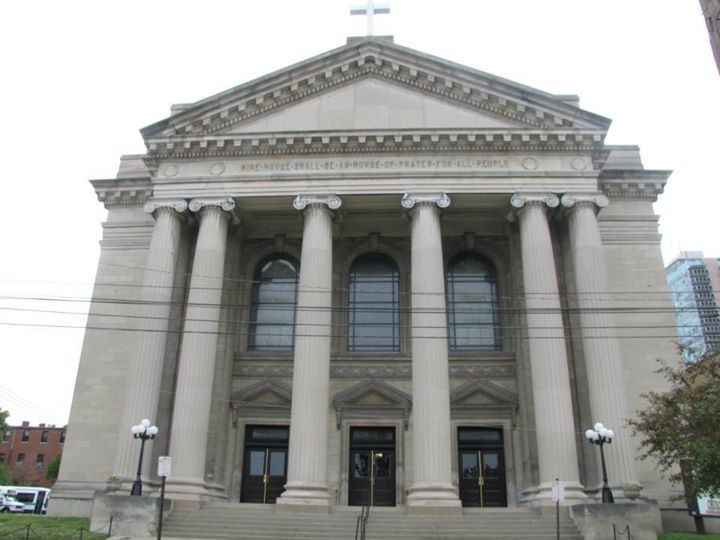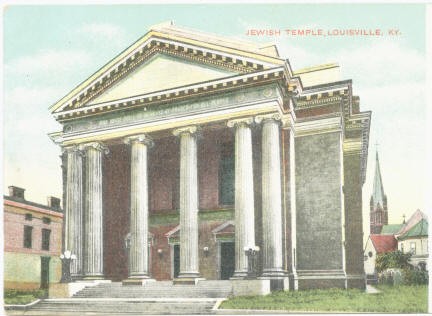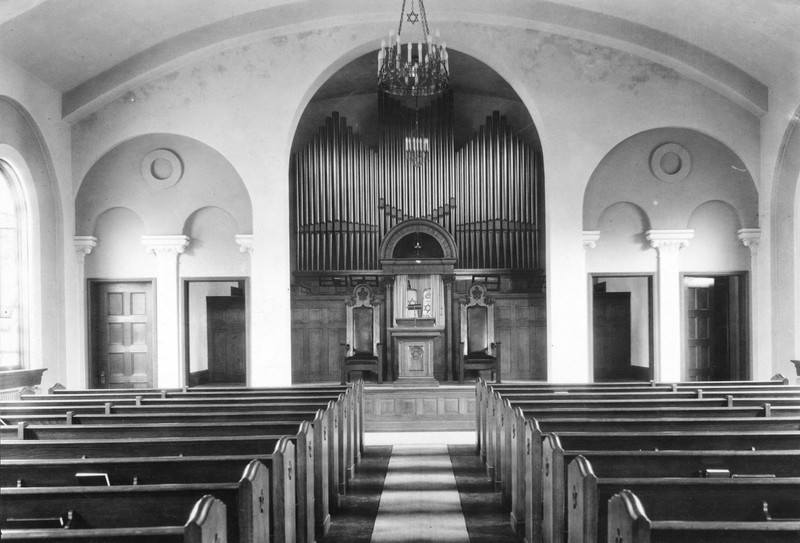Temple Adath Israel (Greater Bethel Temple of the Apostolic Faith)
Introduction
Text-to-speech Audio
Images
Temple Adath Israel (now the Greater Bethel Temple of the Apostolic Faith) (image from Pinterest)

Historic postcard of Temple Adath Israel (image from Old Louisville Historic Neighborhood Association)

Interior of the Temple (image from the University of Kentucky Library)

Backstory and Context
Text-to-speech Audio
Adath Israel, the oldest Jewish congregation in the five-state region around Kentucky, was officially chartered as the K.K. Adas Israel traditional synagogue on January 13, 1843. The city may have been home to Jewish citizens and landowners as early as the late 1700s, and certainly by the early nineteenth century, but it was in the 1830s that Jewish institutions began to appear, including the Israelite Benevolent Society, along with official gatherings for worship. Most of Louisville's early Jewish residents came from German states (especially Posen, a province of Prussia), and the official language of the synagogue was German until the 1860s when English services were introduced. At first, Adath Israel met in rented rooms on Main, near Brook Street. In 1849, the congregation erected a two-story building on 4th near Walnut (present-day Muhammad Ali Boulevard), but it was destroyed by fire in 1866. Two years later, construction was completed on a new temple at 6th and Broadway. In addition to its religious functions, the synagogue also served as a center for secular community work and charity. Visits from Dr. Isaac M. Wise (of Cincinnati) convinced the congregation to join the Reform Judaism Union of American Hebrew Congregations in 1873, making Adath Israel the second largest Reform temple. Rabbi Adolph Moses, a medical doctor from Alabama who had attended Louisville College, added a Sabbath School during his tenure from 1881-1902.
A new congregation, Brith Sholom, was established by a fresh generation of German Jewish immigrants in 1880. Traditional services, with Reform overtones, were held in their native German at a temple at 1st and Walnut (now Muhammad Ali). In 1903, Brith Sholom sold their first temple to Congregation Anshei Sfrard and moved to a new location at 2nd and College Streets. The congregation officially joined the Reform movement in 1920, and in 1949 relocated to Cowling and Maryland Streets.
Twentieth Century Temple
Just after the turn of the century, the Adath Israel Sisterhood was established, followed by the construction of a new temple for the congregation at 834 South Third Street from 1905-1906. The National Register of Historic Places nomination form attributes the building design to W.J. Dodd (1862-1930), but Lee Shai Weissbach's more comprehensive book, The Synagogues of Kentucky: Architecture and History, attributes the design to Louisville architectural firm McDonald and Sheblessy.
With minimal ornamentation except for Classical motifs on the capitals and arches, the Temple is a modified Greek cross plan constructed of Bedford, Indiana limestone. A brick section behind the sanctuary held an auditorium, library, religious school, and the rabbi's study.
As members of the congregation moved to homes further from downtown Louisville, toward the East End, during the mid-twentieth century, land was purchased for a new temple off Brownsboro Road, which also holds archives and exhibits on local and national Reform Jewish history. During its construction, in 1977, Adath Israel and Brith Sholom joined to form one congregation and moved into their new synagogue in 1980. Today, the Temple on 3rd Street is home to the Pentecostal church Greater Bethel Temple of the Apostolic Faith.
Sources
2. Kentucky Historical Society. Historical Marker Database: Jefferson County. Accessed March 10, 2017. http://migration.kentucky.gov/kyhs/hmdb/MarkerSearch.aspx?mode=County&county=56.
3. Kleber, John E. "The Encyclopedia of Louisville." The University Press of Kentucky. Lexington. 2001:875.
4. Rosenblum, James M. "Temple Adath Israel." National Parks Service, National Register of Historic Places. August 29, 1974. Accessed March 13, 2017. https://npgallery.nps.gov/NRHP/GetAsset/2bd04519-e95f-4f0d-a71e-9a9d5fe0482b?branding=NRHP.
5. The Temple: Congregation Adath Israel Brith Sholom. Official Website. Accessed March 20, 2017. http://www.thetemplelouky.org/.
6. Marty Lyn Poynter Hedgepeth, The Victorian to the Beaux-arts: A Study of Four Louisville Architectural Firms, University of Louisville, 1985.
